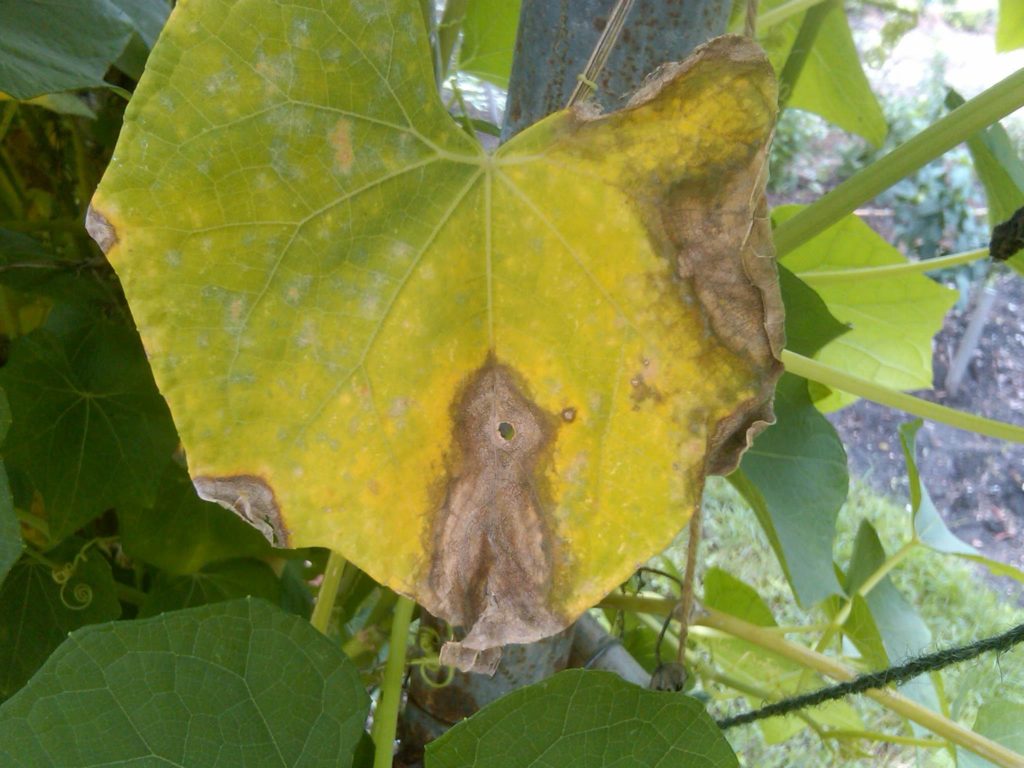
Mirliton leaf infected with anthracnose. Unlike powdery mildew which yellows uniformly and wilts the leaves, anthracnose starts as yellow wedges between the leaf veins. It then turns the leaf tissue brown and leaves with a distinctive “shot hole.”
Anthracnose is a summer disease caused by many fungi, but the pathogen that affects mirlitons is Colletotrichum lagenarium. For the purposes of this article, I will call Colletotrichum lagenarium the “anthracnose fungus. It is a chronic problem with mirlitons and it’s the main reason plants die the first year. There is no known synthetic or biological fungicide that can prevent or eradicate anthracnose in mirlitons. But anthracnose is like a sprained ankle; you can’t prevent it or take a pill to cure it, but you can minimize the risk of getting it and speed up the healing process.
Anthracnose and powdery mildew (PM) are fungal diseases that start with a common sign; leaf yellowing (chlorosis). It’s important to recognize the difference because powdery mildew can be treated, while anthracnose can’t. The PM fungus spreads on the surface of leaves, initially as faded yellow dots and then yellowing the whole leaf until it wilts and dies. Anthracnose, in contrast, grows inside the leaf cells and spreads cell-to-cell (intercellularly)l, so it tends to spread between the leaf veins and form sharp wedges. It kills the tissue within the wedge spreading across to the whole leaf, so you will see both yellow and brown tissue in the same wedge photo.
Mirlitons tend to experience anthracnose epidemics in July and August because of rain patterns. Intensive rains splash up anthracnose fungi from the ground onto the plant stem. The fungus incubates during warm nights and produces thousands of spores that are contained in a sticky base. Rainstorms dissolve the sticky film which releases the spores. Then, raindrops splash the spores to adjacent leaves–and that’s why anthracnose epidemics occur during the hot rainy season.
Anthracnose infects every part of the vine, including leaves, petioles, and stems. It will eventually split the stem, preventing the flow of nutrients to the ends of the stem, so suddenly a whole section of the vine will wilt and die. The good news is that for every stem lost, a healthy vine will send up a new shoot. It is a tug-of-war with the disease through the summer, but generally, the disease will disappear by September in time for flowering and fruiting.
The key to surviving an anthracnose epidemic is to have a healthy vine in place before the epidemic. That means a well-drained and aerated vine. When the soil is water-saturated and no oxygen is available in the root zone, plants go through dramatic changes to survive. They are literally in “anoxic” soil like the dead zones in the Gulf of Mexico. They shift from aerobic metabolism to anaerobic metabolism: they have only 5% of the energy efficiency they have in healthy aerated soil; they produce toxic organic and inorganic compounds, and they deprive leaves of potassium crucial to maintaining leaf functions. After 24-48 hours, the roots have been damaged making it more difficult for them to uptake water and nutrients. Leaf functions are weakened and the whole plant is vulnerable to disease.
The good news is that a mirliton will acquire increased resistance to anthracnose every time it gets the disease. If your vine gets anthracnose this year, it is less likely to get it next year.
The solutions are simple.
Ground Planting:
Make sure the soil is well-drained and aerated. Plant on your highest area available, use planting hills, and stay away from roofs. Plant near a tree if you have one; trees are natural sponges and tend to stabilize soil moisture. If you already have the vine planted, you can dig shallow drainage trenches to remove excess rainfall away from the vine or add a corrugated drain pipe or a French drain.
Raised-bed Planting:
Remember that a raised bed can’t drain into a saturated yard, so you need to construct a bed that will permit excess rainfall to escape the bed via the sides. Add a lateral route for excess water to exit above ground level by drilling 1/4 “ holes along the side panels.
Summary:
For now, the best protection against anthracnose is (1) to use only locally grown heirloom mirlitons for seed since they are likely to have some resistance to anthracnose; (2) plant in well-drained, aerated sites; (3) provide plenty of trellis space so leaves on top can spread out and get maximum exposure to the sun (a natural fungicide) and air circulation; (4) minimize leaf/soil contact by using an overhead horizontal trellis at least 4 feet above the soil and (5) always irrigate gently with a hose set on low on the surface or drip irrigation to prevent splash-up of soil-borne fungi. Do not water mirlitons from the top down. Once leaves and stems are brown and dead, remove them and dispose of them away from the vine.
Click here to see photos of anthracnose infection signs on leaves and stem at different stages (click on each photo for descriptions)
Click here for how to identify and manage powdery mildew.